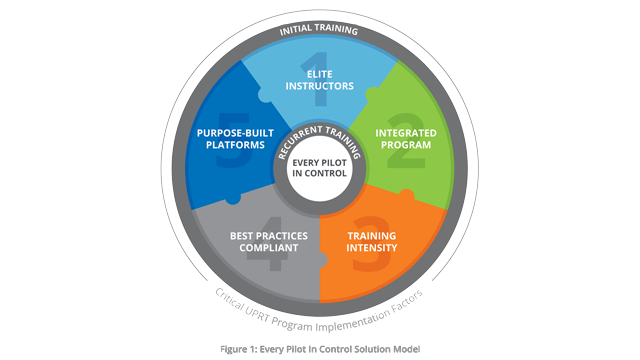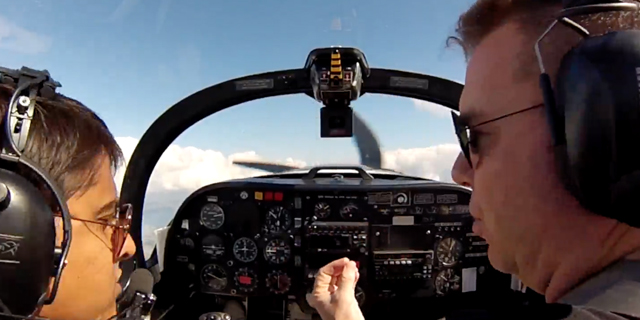Aviation can compete with any industry for its adoption and incorporation of acronyms. Many of them would be common and understood by any pilot, but some belong to specific systems or training, and are not widely known or understood. A good example would be the AAURS™, which stands for the APS All-Attitude Upset Recovery Strategy™. One of the chief areas of misunderstanding is that the AAURS™ is just about four words, “Push, Roll, Power, Stabilize” that are announced during its use. This confusion is easy to explain, since one of the great benefits of the strategy is its simplicity. However, there is a major difference between something being simple, and something being simplistic, which the AAURS™ certainly is not. Let’s examine why.

To begin with, the AAURS™ is a proven, strategy-based intervention system incorporating psychological and physiological considerations to create a structured methodology that is central to overcoming Loss of Control In-flight (LOC-I), which is the number one cause of aviation fatalities in every sector of aviation worldwide. This strategic approach was pioneered by, led by, and is proprietary to APS.
AAURS™ Genesis
The AAURS™ was the product of a 10 year gestation period, and was initially borne of two separate recovery strategies. Every pilot is familiar with two required training tasks that are revisited during nearly every checkride or training event: unusual attitudes, and stalls, or approach to stalls. While these two regulatory training tasks may be separate, the laws of aerodynamics have no such delineation, a pilot can experience both situations simultaneously, and for reasons we won’t go into here, it is quite likely that they may.

It is fair for a student confronted with both an unusual attitude and a stall simultaneously to ask, “Which recovery strategy should I use, the one for unusual attitudes or the one for stalls?” With a bit of inventiveness, APS found a way to rearrange the two strategies into a single approach that could address both situations. In fact, it encompassed recoveries from a broad array of upset events: approach to stalls, fully developed stalls, nose high or nose low upsets, wake turbulence encounters, cross control stalls, and even incipient spins could all be solved using a similar overarching strategic approach. An extremely powerful tool to defeat LOC-I had been born, but there are many elements that ultimately make the AAURS™ so useful and effective.
A Strategy, Not a Procedure
One point of confusion regarding the AAURS™ is the term “strategy”. Pilots are familiar with checklists and procedures, but responding to the seemingly infinite variations aircraft upsets presents a demand for flexibility to adapt dynamic situations. This strategic approach prioritizes decisions and actions for rapid response incorporating the parameters encountered. Understanding this distinction helps to explain why an academic basis and practical skill development are critical to correct implementation of the AAURS™.
A Key Element of the Overall LOC-I Solution Set

The AAURS is the most visible, front-line manifestation of a much larger and in-depth system of LOC-I mitigation represented by the Every Pilot In Control Solution Standard™ (EPIC-S2™) as developed, evolved, audited, and operationally implemented by APS. The EPIC-S2 is beyond the scope of this immediate discussion, however, it is structured around Six Critical UPRT Program Implementation Factors within which the AAURS™ plays a foundational role in the practical implementation of intervention techniques applicable to virtually all types of fixed-wing airplanes.

Built of Reinforcing Components
Just as the AAURS is only a singular component of the overall (EPIC-S2) concept, the AAURS™ is composed of many different dimensions evolved and developed over 25 years:
- Both Non-type-specific and Type-specific – The AAURS™ is based on aerodynamic and physical principles that affect all fixed-wing aircraft. This provides roughly 85% commonality for all airplane types, and allows accommodation for type specific considerations such as swept-wing or straight-wing, jet or prop, etc.
- Cross-fleet Transferable – This strategic approach allows the same techniques and call outs to be used as pilots move between aircraft types for a specific airline, operator, or military organization.
- Exceptions and Variations by Event and/or Airplane Models – The maturity of the AAURS™ has allowed for the clear understanding and identification of its application in every conceivable upset condition or airplane type. This flexibility allows it to be employed effectively in the face of a nearly infinite set of upset parameters or possibilities.
- Associated Instructional Design and Scalability – The building block approach to AAURS™ knowledge and skills are based on the integration of several components (foundational academics, and practical skill development both on-aircraft, and through flight simulation) that take advantage of instructional system design concepts. Courses are created and structured in a way that allows for easy scalability and efficiency.
- Recall Technology, Say & Do Techniques, Learning Acceleration – Vast experience in educating thousands of pilots has led to the development of uniquely focused syllabi and flight profiles resulting from decades of refinement. Correlation between spoken words and actions facilitates both learning and application despite cognitive impairment present in unexpected upset events.
- CRM Integration – Alignment between Pilot Flying and Pilot Monitoring priorities, terminology, and actions promotes mutual understanding and support even in time critical, life threatening situations.
- Instructor Training, Qualification, Certification and Standardization – Experience in training hundreds of instructors has distilled the process of instructor education, and led to the creation of clear definitive standards for instructor proficiency and capability.
- Regulatory compliance – The AAURS™ has been modified and evolved over the years to accommodate regulatory changes that have been made related to improved understanding of the LOC-I threat, and recovery concepts.

The Result
The end result of all of the many components described above is an overall system, the AAURS™. It provides a robust, integrated, comprehensive training solution. Most importantly, this powerful tool provides a long lasting skill set that is accessible in crisis. It creates confident, competent, more resilient pilots that are more capable of preventing and recovering from unanticipated upset events.
More Than Just Words
As you can see from this explanation, the AAURS™ is about much more than just words or call outs. In fact, the words used have changed over the years as guidance has changed, they can be reordered slightly in certain situations to optimize recoveries and improve margins of safety. The words used are comparatively minor to the complexity, depth, and breadth of the AAURS™ as deployed within the EPIC-S2 mitigation system. There are other word choices and arrangements used by others, but none have the proven effectiveness of the AAURS™ which comes from its sophisticated, multi-layered approach to the complexities of the LOC-I threat.
The Central Goal Remains the Same
The motivating question, first asked over 25 years ago, was how do we teach pilots what they need to reduce the LOC-I threat? What information or tools can we give them? How can we help them to bring everyone home safely? The answer to that question is what has now become the AAURS™. It is the structured methodology used by APS to meet its brand promise: Every Pilot Trained – In Control – All The Time.




Comments: